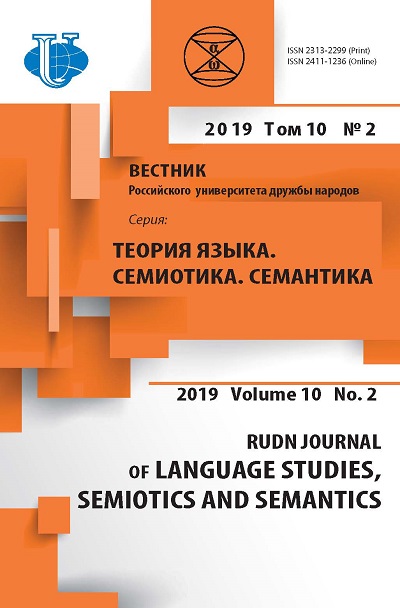ARCHETYPE AND LOGOS OF FURNACE AND FIREPLACE
- Authors: Gerasimova S.V.1
-
Affiliations:
- Moscow Polytechnic University
- Issue: Vol 10, No 2 (2019)
- Pages: 353-372
- Section: PHRASE RESOURCES
- URL: https://journals.rudn.ru/semiotics-semantics/article/view/21754
- DOI: https://doi.org/10.22363/2313-2299-2019-10-2-353-372
- ID: 21754
Cite item
Full Text
Abstract
The article is literary in nature: the example of the furnace shows the difference between the logos and the archetype, as well as the principles of modifying the logos into an archetype. The aim of the work is to systematize a wide range of values of the archetypal symbol of the furnace, finding the sacred logos to which they ascend. The article is written on the material of ancient mythology and literature of the New Time: the archetypical images, related to the archetype of the furnace, such as the affected heel, fire, serpent, are analyzed - their relevance to world culture and literature, related to their repeatability and stability, is proved. So it is concluded that there is a close relationship between all the elements of the semiotic system: as a result of the disappearance of one of the furnaces, the archetype of the furnace, from everyday culture, the attitude and principles of human behavior changed, which radically affected the course of history.
About the authors
Svetlana V. Gerasimova
Moscow Polytechnic University
Author for correspondence.
Email: metanoik@gmail.com
SPIN-code: 4006-9266
Ph.D. in Philology, Associate Professor, Department of Russian Language and Literature History of the Higher School of Press and Media Industry of the Moscow Polytechnic University
St. Bolshaya Semenovskaya, 38, Moscow, Russia, 107023References
- Maksimov, S.V. (2008). Russian rites and superstitions. Unclean, unknown and godmother power. Backwoods. Moscow: Prestige Book. URL: http://ocherk.org/maksimov-s-v--russkieobryadi-i-sueveriya/index.html (accessed: 04.03.2019).
- Agranovich, S.Z. & Stefansky, E.E. (2003). Myth in the word: the continuation of life. Essays on mytholinguistics. Samara. URL: http://zavantag.com/docs/427/index-2017438.html (accessed: 23.03.2019).
- Klushina, E.A. (2006). The furnace in the beliefs of the Andomsky Pogost // Ethnological archive of the TsMB of the RSUH. Expedition 2006. URL: http://cmb.rsuh.ru/article.html?id=72198 (accessed: 04.03.2019).
- Gogol, N.V. (2005). The Lost Letter. In Russian literature: from Nestor to Mayakovsky. Moscow: DirectMedia Publishing. (In Russ.).
- Sretensky Calendars Sunday, December 30 December 17 Art. Art. Week 31st of Pentecost, the week of the holy forefathers. Prophet Daniel. The three holy men: Ananias, Azariah, and Mishael. URL: http://msm.dev-serv.ru/calendar/?day=30.12.2018&e=143 (accessed: 03.03.2019).
- Tolstoy, L.N. (1980). War and World. In Collected Works in 22 vols. Vol. 5. Moscow: Hudozhestvennaya literatura. (In Russ.).
- Bestuzhev, A.A. (2005). Evening on the Caucasus waters in 1824. In Russian literature: from Nestor to Mayakovsky. Moscow: DirectMedia Publishing. (In Russ.).
- Gogol, N.V. (2005). Evenings on a farm near Dikanka. In Russian literature: from Nestor to Mayakovsky. Moscow: DirectMedia Publishing. (In Russ.).
- Balmont, K.D. (2005). Translations. From English poetry. Oscar Wilde Ballad of Reading Prison. In Russian literature: from Nestor to Mayakovsky. Moscow: DirectMedia Publishing. (In Russ.).
- Avdeenko, E.A. Abraham's life. URL: http://www.klex.ru/iy9 (accessed: 05.03.2019).
- The Holy Fire came down in the Church of the Holy Sepulcher in Jerusalem // Tass. URL: https://tass.ru/obschestvo/4185784 (accessed: 23.03.2019).
- Propp, V.Ya. The historical roots of the fairy tale. URL: https://royallib.com/book/propp_ vladimir/istoricheskie_korni_volshebnoy_skazki.html (accessed: 05.03.2019).
- Belousov, A.V. (2008). Der Achilleus-Kult im nördlichen Schwarzmeerraum vom Beginn der griechischen Kolonisation bis in die römische Kaiserzeit. Beiträge zur Akkulturationsforschung. PSTU Bulletin III: Philology, 1 (11), 117—130.
- Salnikov, A.A. (2012). Homer's laughter over Achilles. Moscow: LireRes. (In Russ.).
- Dostoevsky, F.M. (1989). Idiot. In F.M. Dostoevsky. Collected Works in Fifteen Volumes. Vol. 6. Leningrad: Nauka. (In Russ.).
- Anthony the Great, holy. Instructions // Philokalia in 5 vols. T. 1. Siberian Starfish; Moscow; 2010. P. 9—81.
- Soldatova E., Artyomova I., Vorobyov A., Klamer N., Oleksyuk S., Galchikhina I., Inozemtsev V. Kupel built the whole world // Istrinskie Vesti. 2015. January 23. № 3. P. 5. URL: http://in-istra.ru/ upload/126_0ffb8cc06eab935c0835fa8f5f23612b396b2949.pdf (accessed: 02.05.2019).
- Rostov Dimitri. Of life. URL: https://azbyka.ru/otechnik/Dmitrij_Rostovskij/zhitija-svjatykh/63 (accessed: 27.04.2019).
- Dostoevsky, F.M. (1991). Brothers Karamazov. In F. Dostoevsky. Collected Works in Fifteen Volumes. Vol. 9. Leningrad: Nauka. (In Russ.).
- Losev, A.F. Myth. Number. Essence M.: Thought, 1994 (In Russ.).
- Dostoevsky, F.M. (1990). Demons. In F.M. Dostoevsky. Collected Works in Fifteen Volumes. Vol. 7. Leningrad: Nauka. (In Russ.).
- Isaiah, Abba of Nitria. (2010). The words of the Rev. Abbas Isaiah to his disciples. In Philokalia in 5 volums. Vol. 1. Siberian Starfish; Moscow. pp. 143—223. (In Russ.).
- Lotman, Yu.M. On the semiosphere. In Yu.M. Lotman. Articles on semiotics and topology of culture. URL: http://yanko.lib.ru/books/cultur/lotman-selection.htm (accessed: 05.03.2019). (In Russ.).
- Frolova, N.M. (2018). Features of the language representation of the concept of “Life” in the play by L.N. Andreev “Life of a Man”. Bulletin of the RUDN. Series: Theory of Language. Semiotics. Semantics, 9 (4), 842—858. (In Russ.).
Supplementary files












